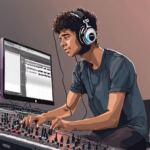
Mastering Layering and Texturing: Creating Depth in Sound Design
लेयरिंग और टेक्सचरिंग: साउंड डिज़ाइन में गहराई बनाने की प्रक्रिया
Mastering Layering and Texturing are fundamental techniques in sound design, used to add depth, richness, and complexity to audio. These methods help transform simple sounds into immersive experiences, whether in music, films, gaming, or virtual reality.
लेयरिंग और टेक्सचरिंग, साउंड डिज़ाइन में ध्वनि को अधिक वास्तविक और प्रभावशाली बनाने की प्रक्रिया है। यह कला और तकनीक का अद्भुत संयोजन है।
This article explores the intricacies of layering and texturing, their applications, tools, and the creative process involved in achieving professional results.
1. What is Layering? | लेयरिंग क्या है?
Layering in sound design involves combining multiple audio elements to create a single, cohesive sound. Each layer contributes unique qualities, such as tone, texture, or dynamics, making the final result richer and more engaging.
For example:
- A gunshot sound in a movie might be created by layering the crack of a whip, the boom of a cannon, and the metallic click of a trigger.
- In music, a bassline might have a sub-bass layer for depth, a mid-bass layer for punch, and a higher layer for harmonics.
लेयरिंग का उद्देश्य ध्वनि को यथार्थवादी और संपूर्ण बनाना है। यह प्रक्रिया श्रोताओं को एक बेहतर अनुभव प्रदान करती है।
2. What is Texturing? | टेक्सचरिंग क्या है?
Texturing refers to adding subtle details and ambiance to a sound to make it feel more natural or immersive. Textures often include environmental sounds, such as wind, water, or distant noises, which enhance the atmosphere.
For instance:
- The sound of a forest might combine bird chirps, rustling leaves, and distant streams.
- A cinematic explosion might have a rumbling bass texture, a high-pitched sizzle, and debris sounds for realism.
टेक्सचरिंग का उपयोग ध्वनि में गहराई और वातावरण जोड़ने के लिए किया जाता है। यह ध्वनि को अधिक प्रभावशाली बनाता है।
3. Importance of Layering and Texturing | लेयरिंग और टेक्सचरिंग का महत्व
Layering and texturing are critical in creating sounds that captivate the audience. Without these techniques, audio may feel flat or uninspired. Here’s why they matter:
a. Adding Realism | वास्तविकता जोड़ना
In film and gaming, realism is crucial. Layered and textured sounds make environments feel alive and believable.उदाहरण के लिए, बारिश की आवाज़ को अधिक वास्तविक बनाने के लिए अलग-अलग परतें जोड़ी जाती हैं, जैसे पानी गिरने की आवाज़ और हवा की गूँज।
b. Enhancing Emotion | भावनाओं को बढ़ाना
In music, layering helps evoke emotions by combining sounds with different tonal qualities. Textures, such as reverb or echo, add emotional depth.
c. Creating Unique Sounds | अनूठी ध्वनियाँ बनाना
Layering and texturing allow designers to craft signature sounds that stand out. This is especially important in branding or when creating distinct identities for characters or environments.
4. Tools Used for Layering and Texturing | लेयरिंग और टेक्सचरिंग के उपकरण
a. Digital Audio Workstations (DAWs) | डिजिटल ऑडियो वर्कस्टेशन
DAWs like Ableton Live, Logic Pro, and Pro Tools provide the foundation for layering and texturing. They allow designers to stack and manipulate audio tracks.
b. Synthesizers | सिंथेसाइज़र
Synthesizers like Serum, Massive, and Omnisphere are used to create layers of sound, from bass to pads and leads.
c. Effects Plugins | इफेक्ट्स प्लगइन्स
Plugins like reverb, delay, and granular synthesis tools help add texture to audio.इन प्लगइन्स के माध्यम से ध्वनि में गहराई और जटिलता जोड़ी जाती है।
d. Field Recorders | फील्ड रिकॉर्डर
High-quality field recorders capture environmental sounds that can be used as textures.
e. Sample Libraries | सैंपल लाइब्रेरीज़
Sample libraries like Splice and Kontakt offer pre-recorded sounds that can be layered or textured.
5. The Process of Layering and Texturing | लेयरिंग और टेक्सचरिंग की प्रक्रिया
Step 1: Identifying the Core Sound | मुख्य ध्वनि पहचानना
The process begins with identifying the base sound. This could be a melody, a sound effect, or a vocal line.
मुख्य ध्वनि वह आधार है, जिस पर लेयरिंग और टेक्सचरिंग की प्रक्रिया आधारित होती है।
Step 2: Adding Complementary Layers | पूरक परतें जोड़ना
Once the core sound is ready, complementary layers are added. For example:
- A drum track may include layers for kick, snare, hi-hats, and percussion.
- A vocal may have layers for harmony, double tracking, and effects.
Step 3: Applying Texture | टेक्सचर जोड़ना
Textures are then added to enhance the sound’s depth. This might include subtle noises, ambient sounds, or effects.
Step 4: Balancing and Blending | संतुलन और सम्मिश्रण
The final step is ensuring all layers and textures blend seamlessly. This involves:
- Volume Balancing: Ensuring no layer overpowers the others.
- EQ (Equalization): Adjusting frequencies to avoid clashing.
- Panning: Distributing sounds in the stereo field for space.
6. Applications of Layering and Texturing | लेयरिंग और टेक्सचरिंग के उपयोग
a. Music Production | संगीत निर्माण
In music, layering and texturing are used to add richness to tracks. A simple chord progression can be transformed into an emotional masterpiece with these techniques.
b. Film Soundtracks | फिल्म साउंडट्रैक
Layering explosions, footsteps, and ambient sounds make movie scenes more engaging and realistic.फिल्मों में, टेक्सचरिंग से दृश्य अधिक जीवंत बनते हैं।
c. Video Games | वीडियो गेम्स
In gaming, dynamic layering ensures sounds react to player actions, creating an immersive experience.
d. Virtual Reality (VR) | वर्चुअल रियलिटी
Layering and texturing in VR help create believable environments that engage multiple senses.
7. Challenges in Layering and Texturing | लेयरिंग और टेक्सचरिंग में चुनौतियाँ
a. Overcrowding | बहुत अधिक लेयरिंग
Too many layers can make a sound muddy or cluttered.सही संतुलन बनाना सबसे बड़ी चुनौती है।
b. Lack of Resources | संसाधनों की कमी
High-quality plugins and tools can be expensive.
c. Time-Consuming Process | समय-लेवा प्रक्रिया
Achieving the perfect balance and texture often requires significant time and effort.
8. Tips for Effective Layering and Texturing | प्रभावी लेयरिंग और टेक्सचरिंग के लिए सुझाव
- Keep It Simple | सरल रखें: Avoid overcomplicating layers.
- Focus on Contrast | कंट्रास्ट पर ध्यान दें: Use contrasting textures to make sounds stand out.
- Experiment | प्रयोग करें: Try unconventional combinations for unique results.
- Use Automation | ऑटोमेशन का उपयोग करें: Automate effects like volume or reverb for dynamic textures.
Conclusion | निष्कर्ष
Layering and texturing are powerful tools that elevate sound design from good to exceptional. By carefully combining and enhancing audio elements, sound designers create immersive experiences that captivate audiences across various mediums.
“Great sound design is not just heard; it’s felt.”“महान साउंड डिज़ाइन केवल सुनी नहीं जाती, बल्कि महसूस की जाती है।”


